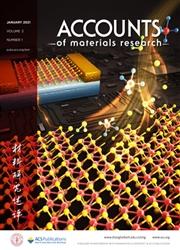Vat Photopolymerization 3D Printing of Conductive Nanocomposites
IF 14.7
Q1 CHEMISTRY, MULTIDISCIPLINARY
引用次数: 0
Abstract
Recent years have witnessed a surge in efforts to integrate electrically conductive nanomaterials into photopolymer-based additive manufacturing (AM), driven by the growing demand for multifunctional 3D-printing. While several AM techniques have been adapted to process conductive composites, Digital Light Processing (DLP) stands out for its high-resolution and fast-curing capabilities. However, it poses a central limitation: the requirement for optical transparency in the printing resin, which is compromised by the incorporation of conventional conductive fillers. This Account highlights the advances in overcoming three fundamental challenges in the field: (i) How can conductive nanocomposites be printed by DLP without compromising resolution? (ii) How can high electrical conductivity be achieved at low filler content? (iii) What is the origin of anisotropic conductivity in printed objects, and how can it be mitigated?

导电纳米复合材料的还原光聚合3D打印
近年来,在多功能3d打印需求不断增长的推动下,将导电纳米材料集成到基于光聚合物的增材制造(AM)中的努力激增。虽然已有几种增材制造技术被用于加工导电复合材料,但数字光处理(DLP)以其高分辨率和快速固化能力脱颖而出。然而,它提出了一个核心限制:印刷树脂的光学透明度要求,这是由传统的导电填料的掺入折衷。本报告强调了在克服该领域的三个基本挑战方面取得的进展:(i)如何在不影响分辨率的情况下通过DLP打印导电纳米复合材料?(ii)如何在低填料含量下实现高导电性?(三)印刷物体的各向异性电导率的来源是什么,如何减轻这种现象?
本文章由计算机程序翻译,如有差异,请以英文原文为准。
求助全文
约1分钟内获得全文
求助全文

 求助内容:
求助内容: 应助结果提醒方式:
应助结果提醒方式:


